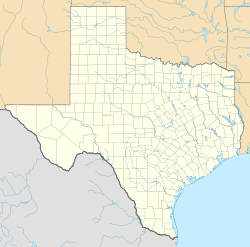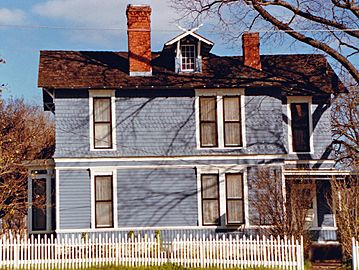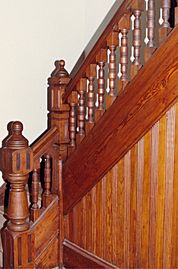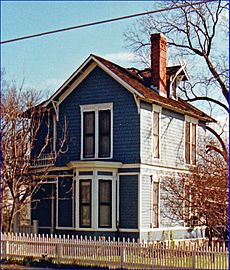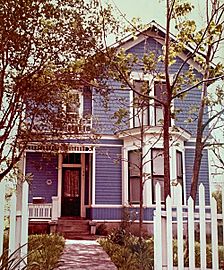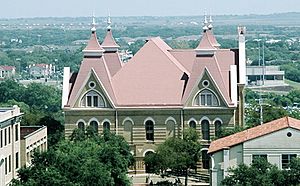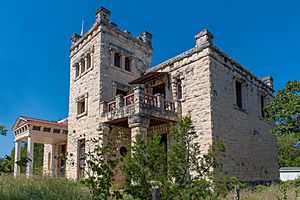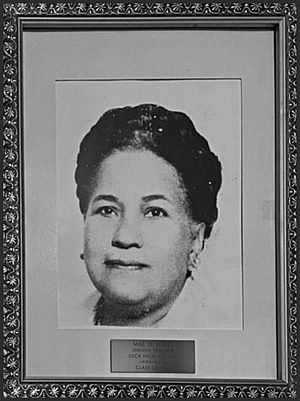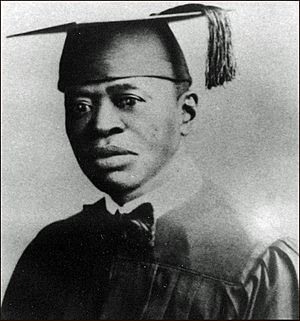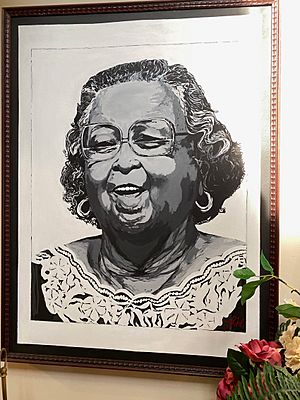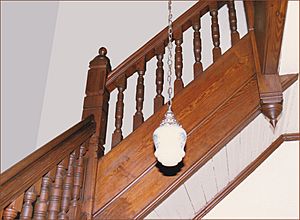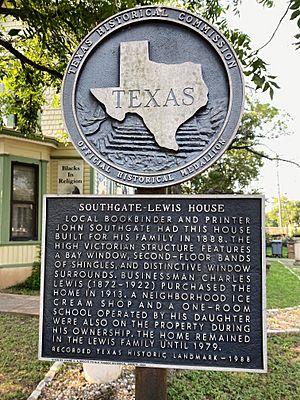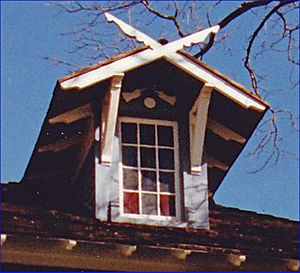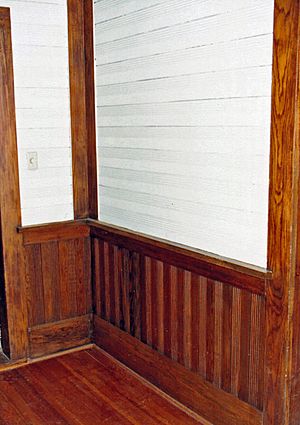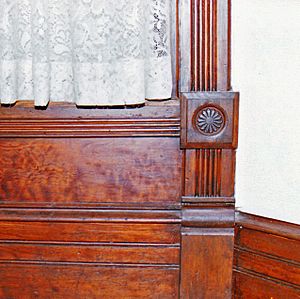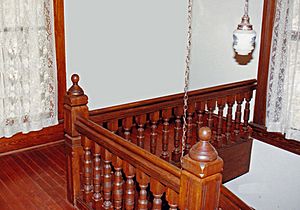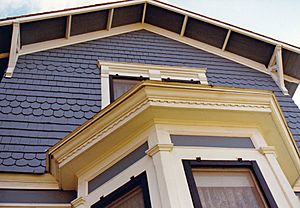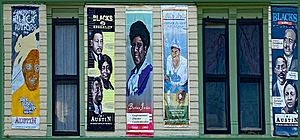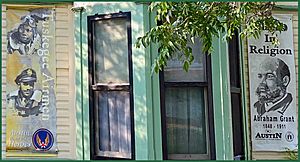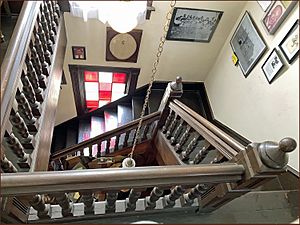Southgate–Lewis House facts for kids
|
Southgate–Lewis House
|
|
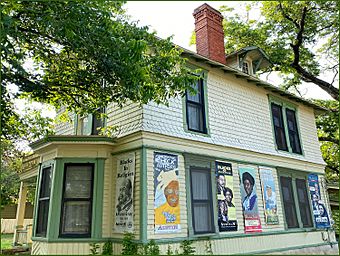
Southgate–Lewis House in June 2021.
|
|
| Location | 1501 East 12th Street Austin, Texas, USA |
|---|---|
| Area | East Austin |
| Built | 1888 |
| Architect | R. C. Lambie |
| Architectural style | Victorian |
| NRHP reference No. | 85002265 |
Quick facts for kids Significant dates |
|
| Added to NRHP | September 17, 1985 |
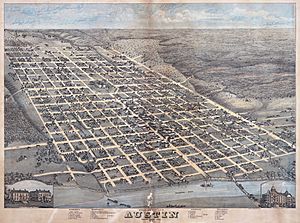
The Southgate–Lewis House is a special old building in Austin, Texas. It is a historic landmark located about one mile east of the Texas State Capitol. You can find it in the middle of Austin's "African American Cultural Heritage District."
Contents
About the Southgate–Lewis House
The Southgate–Lewis House was built in 1888 by a builder named Robert C. Lambie. It has a beautiful late Victorian style, which is quite unique in that area.
The Charles M. Lewis family owned this house for many years, from 1913 to 1979. After Marguerite Mae Dee Lewis passed away in 1970, the house was left empty for almost ten years. It became very run-down and was even thought to be dangerous. The house was planned to be torn down, but it was saved just one week before demolition! It was then carefully fixed up to preserve its history.
Today, the Southgate–Lewis House is recognized as a historic landmark by the city, state, and even the whole country. In 1986, a professor from The University of Texas at Austin gave the house as a gift to the W. H. Passon Historical Society. This society works to find and protect items and stories related to Black culture in Austin and Travis County.
Historic Recognition
The Southgate–Lewis House has received many important recognitions:
- 1979 – It was named a City of Austin landmark.
- 1980 – It won the Heritage Society of Austin Historic Preservation Award.
- 1985 – It was listed as a landmark by the National Register of Historic Places.
- 1987 – The State of Texas recognized it for helping to keep Black heritage alive in Austin.
- 1987 – It received the "Helping Hands Award for Community Service."
- 1988 – It was named a Recorded Texas Historic Landmark.
Gallery
- After 1980 restoration
House Design
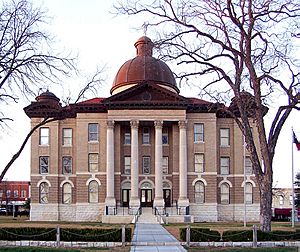
Victorian Style
The National Register of Historic Places describes the house as "High Victorian" Gothic Revival style. This means it has many decorative details. The roof has parts that stick out, and there's a noticeable front section with fancy trim. The outside walls have different patterns, like vertical siding at the bottom and rows of fish-scale and rectangular shingles higher up. The roof is made of wood shingles, and two brick chimneys rise high above it. There are 22 windows in total.
Inside the House
The first floor of the house has five rooms. When you enter, you step into a main hall with a staircase leading upstairs. From the hall, you can go into the main living room, which has a fireplace with colorful tiles. Large sliding doors connect the first living room to a second one. This second room has a door to a covered porch and another door to the dining room. The dining room has wood panels on the walls and ceiling. From the dining room, you can enter a small kitchen, which also has a door to the porch.
Upstairs, on the second floor, there are three bedrooms, a small closet, a small bathroom, and a large hallway. A big window in the hallway opens onto a small outdoor balcony.
History of the House
Robertson Hill Area
The area where the Southgate–Lewis House stands is called Robertson Hill. It was named after Joseph William Robertson, a doctor and Texas Ranger. He bought a large piece of land in 1848 and started selling smaller lots. This is how Robertson Hill became a neighborhood.
College Street in 1873
An old map from 1873, called "Bird's Eye View of the City of Austin," shows what Austin looked like before the house was built. The Southgate–Lewis House was constructed only 15 years after this map was made. Back then, Austin had about 10,000 to 15,000 people.
The map shows that College Street (where the house is) was a main street. It led directly from the State Capitol Building up into the Robertson Hill area, where new homes were being built. This shows that the Southgate–Lewis House was built on an important street.
Street Names Changed
On September 21, 1886, Austin changed its street names to numbers. College Street became 12th Street. The Southgate–Lewis House is located at 1501 East 12th Street.
John Southgate
John Southgate was a bookbinder and publisher in Austin. He hired Robert C. Lambie to build the house in 1888. Southgate was known for his excellent work, and the local newspaper often praised him.
Robert C. Lambie, the Builder
Robert C. Lambie built many famous buildings in Texas with his partner, Francis Fischer. Some of his other projects include:
- The first Engineering Building at The University of Texas at Austin.
- The historic home and studio of German sculptor Elisabet Ney, now the Elisabet Ney Museum.
- The Old Main Building at Texas State University.
- The Hays County Courthouse.
Lambie was famous for his detailed woodwork, which you can see in the beautiful staircases, door frames, and window frames of the Southgate–Lewis House. The State of Texas Legislature even said the house has "one of the finest staircases in all of Austin."
The Lewis Family
The Charles M. Lewis family lived in the house from 1913 to 1970. Charles M. Lewis was an important Black citizen in Austin and a professor at Samuel Huston College. His daughter, Marguerite Mae Dee Lewis, was a teacher at L.C. Anderson High School, which was very close to their home. A photo of Mae Dee Lewis still hangs in the house today.
L.C. Anderson High School was originally called Robertson Hill High School. It was where African-American students in Austin first had high school classes starting in 1889.
Saving the House
House in Danger
After Ms. Lewis passed away in 1970, the house was empty for almost ten years. It became very damaged. Many windows were broken, and parts of the roof were missing, letting water inside. Pigeons even started living there! Because it was so unsafe, the city decided to tear it down.
A Professor Steps In
In February 1979, just one week before the house was scheduled to be demolished, a new professor named Dr. Duane G. Albrecht moved to Austin. He saw the abandoned Victorian house, which was close to the university. At that time, the house belonged to Mary Elizabeth Lovelady.
Professor Albrecht decided to save the house, fix it up, and make it his home. He received help from The Heritage Society of Austin (now called Preservation Austin). Many people in the community supported his project, including architects and banks that provided loans.
Fixing Up the House
Restoration Work
Peter J. Fears was the skilled craftsman in charge of fixing up the house. He had just finished restoring another historic house nearby.
When Peter Fears started working, he found something special about the house's structure. He discovered that the inside walls were not made of the usual "lath and plaster" (a common building method back then). Instead, they were covered with strong wooden boards called shiplap, laid diagonally. This made the house very sturdy and able to withstand strong winds.
Calcasieu Lumber Company
The wooden boards inside the walls had a stamp from "Calcasieu Lumber Co." This company was founded in 1883, just a few years before the house was built. They were known for using high-quality longleaf pine wood from Louisiana.
During the restoration, many beautiful original features were uncovered, like the fancy staircase, wood paneling, and hardwood floors made from old-growth longleaf pine.
Kitchen Changes
The experts concluded that the house's main layout had not changed much since it was built, except for one thing: the small kitchen. They believed the kitchen was added later and was not part of the original design by Robert C. Lambie.
Donating to the Passon Society
After living in the house for a long time, Professor Albrecht decided to donate the Southgate–Lewis House to the W. H. Passon Historical Society in December 1986. He was encouraged by Ada Marie DeBlanc Simond. The society's goal is to collect and preserve materials about African-American history and create an educational center. The Southgate–Lewis House was a perfect fit for this important work.
W. H. Passon Historical Society
What They Do
The W. H. Passon Historical Society works to find and protect items and stories related to Black culture in Austin and Travis County, Texas. Ada Marie DeBlanc Simond helped start the society in 1975. Their goal is to "unite all individuals... who have a genuine interest in the Past, and an eagerness to discover the depth and breadth of the Black Experience in Austin and Travis County." They want to make sure that Black heritage is recognized and respected in the community.
The House's Role
The Southgate–Lewis House is now the home of the W. H. Passon Historical Society. They plan to make it an educational center with books, journals, and exhibits about Black people. This will help people learn more about the important contributions of Black people. The house is an important African-American Historical Landmark and a place for African-American history and culture.
Wesley H. Passon
Educator
Wesley H. Passon (1864–1933) was a Black educator who did a lot to preserve African-American history in Austin. He was a principal at several early schools for Black children in Austin, including Blackshear School. He also kept detailed records of daily life at some of these schools.
Historian
In 1907, W. H. Passon created a detailed history of the Metropolitan African Methodist Episcopal Church in Austin. This record is still a very important resource for historians today.
Ada Marie DeBlanc Simond
Friend of the Lewis Family
Ada Marie DeBlanc Simond (1903–1989) was an African-American teacher, writer, and historian. She grew up near the Southgate–Lewis House and was a strong supporter of saving it. Ada Simond knew the Charles M. Lewis family very well and was friends with Mae Dee Lewis. She often visited the Southgate–Lewis House. Charles M. Lewis was also a mentor to her and let her attend classes at Samuel Huston College.
Children's Books
Ada Simond used the Lewis family and the Southgate–Lewis House as inspiration for a series of six children's books called Let's Pretend: Mae Dee and Her Family. These books told true stories about Black families living in Austin in the early 1900s, narrated by Mae Dee Lewis. The Texas Historical Commission named this series an "Outstanding Publication on a History Subject" in 1979. Ada Simond also wrote a weekly newspaper column called "Looking Back," which shared stories about Austin's African-American community.
Other Achievements
Ada Simond earned a master's degree and taught at Tillotson College. She received an honorary doctorate and many awards for her work in human rights and education. She was also inducted into the Texas Women's Hall of Fame in 1986. A street in Austin is named in her honor.
Founding the Passon Society
In 1975, Ada Simond helped organize the W. H. Passon Historical Society to help protect the history of Austin's African-American community.
Juneteenth National Independence Day
On June 19, 2021, Juneteenth became a new federal holiday in the United States. It is now officially called Juneteenth National Independence Day. This day celebrates the end of slavery for African Americans in the U.S.
The Southgate–Lewis House, home of the W. H. Passon Historical Society, was part of the Juneteenth celebration in 2021. Banners showing important African Americans in government, education, literature, medicine, and sports were displayed on the house. Other banners showed distinguished African Americans in religion and the military.
House and Education
Throughout its long history, the Southgate–Lewis House has always been connected to education. It started with John Southgate, a bookbinder. Charles Lewis and Mae Dee Lewis were both teachers. The professor who saved the house was an educator. Wesley H. Passon was a respected Black educator. And today, the W. H. Passon Historical Society uses the house to "establish an educational center."


